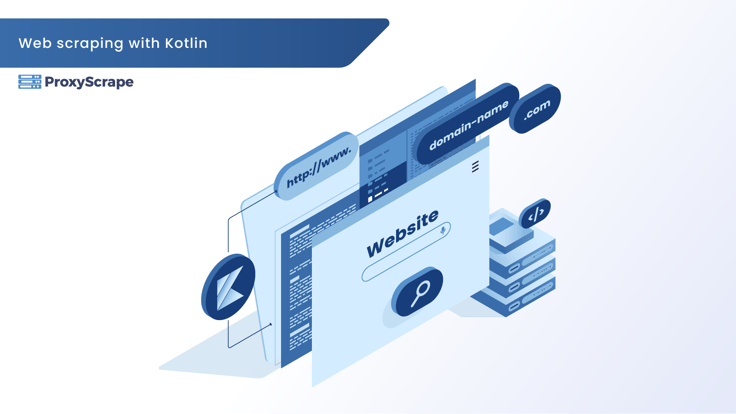Веб-скрапинг с помощью языка программирования Kotlin

В современном мире, основанном на данных, информация - это сила. Тот, кто умеет эффективно собирать и анализировать данные, имеет явное преимущество. Веб-скрепинг быстро стал необходимым инструментом для разработчиков и аналитиков данных, стремящихся извлечь ценную информацию с веб-сайтов. Но почему для этой задачи стоит выбрать Kotlin? Kotlin, современный язык программирования, предлагает свежий взгляд и мощные инструменты для веб-скрейпинга, делая его более простым и эффективным.
Возвышение веб-скрапинга
Веб-скреппинг - это техника, используемая для извлечения данных с веб-сайтов и преобразования неструктурированного контента в структурированные данные. Этот процесс крайне важен для проведения маркетинговых исследований, анализа конкурентов, мониторинга цен и многого другого. Автоматизация сбора огромных объемов данных позволяет компаниям и исследователям сэкономить бесчисленное количество часов и сосредоточиться на извлечении полезных сведений из собранной информации.
Почему Kotlin выделяется
С момента своего появления Kotlin неуклонно набирает популярность, особенно после того, как Google одобрила его в качестве официального языка для разработки под Android. Но привлекательность Kotlin не ограничивается только мобильными приложениями. Лаконичный синтаксис, совместимость с Java и современные возможности языка делают его потенциальным вариантом и для веб-скраппинга.
Настройка Kotlin для веб-скрапинга
Прежде чем приступить к скраппингу, вам нужно настроить среду разработки для Kotlin. Для этого нужно установить необходимые библиотеки, такие как Ktor и Jsoup. Эти библиотеки предоставляют инструменты для выполнения HTTP-запросов и разбора HTML-контента. Вот как их можно установить:
Чтобы включить необходимые зависимости в свой проект, добавьте следующее в свой build.gradle.kts файл:
dependencies {
// Ktor client
implementation("io.ktor:ktor-client-core:2.0.0")
implementation("io.ktor:ktor-client-cio:2.0.0") // CIO engine
// Jsoup
implementation("org.jsoup:jsoup:1.15.3")
}
После того как среда настроена, вы можете использовать следующий код Kotlin для соскабливания данных с сайта Books to Scrape:
import io.ktor.client.*
import io.ktor.client.engine.cio.*
import io.ktor.client.request.*
import org.jsoup.Jsoup
suspend fun main() {
// Initialize the Ktor HTTP client with the CIO engine
val client = HttpClient(CIO)
try {
// Fetch the HTML content from the books.toscrape.com main page
val url = "https://books.toscrape.com/"
val htmlContent: String = client.get(url)
// Parse the HTML content using Jsoup
val document = Jsoup.parse(htmlContent)
// Extract the titles of books (they are inside <h3> tags with <a> inside)
val bookTitles = document.select(".product_pod h3 a")
// Print the extracted titles
bookTitles.forEach { book ->
println(book.attr("title")) // Book titles are in the 'title' attribute of <a>
}
} catch (e: Exception) {
println("Error during scraping: ${e.message}")
} finally {
// Close the Ktor client
client.close()
}
}
Этот скрипт получает HTML-контент с помощью Ktor и разбирает его с помощью Jsoup для извлечения названий книг. Запустив его, вы увидите, насколько простым и в то же время мощным может быть веб-скраппинг с помощью Kotlin.
Оптимизация проектов веб-скрапинга
Эффективность и производительность очень важны при скраппинге, особенно в масштабе. Вот несколько советов, которые помогут оптимизировать ваши проекты по скрапбукингу:
Используйте эффективные методы парсинга:
Отдавайте предпочтение быстрым и легким библиотекам. Например, Jsoup - отличный инструмент для разбора HTML благодаря своей простоте и скорости. Выбирая элементы напрямую, вы сокращаете время обработки и повышаете общую производительность.
Реализуйте обработку ошибок:
Веб-сайты со временем меняются, что может привести к поломкам скреперов. Используйте в коде блоки try-catch для изящной обработки неожиданных ошибок. Ведение журнала ошибок и мониторинг скриптов скраппинга помогут вам быстро реагировать на изменения.
Ограничение скорости и уважительное скрапбукинг:
Чтобы не перегружать серверы запросами, введите ограничение скорости. Вводите задержки между запросами и соблюдайте условия использования сайта в файле `robots.txt`. Это не только предотвратит запрет IP-адресов, но и будет способствовать соблюдению этических норм скрапинга.
Заключение
Веб-скрепинг на Kotlin - это сочетание мощности и простоты, позволяющее разработчикам эффективно собирать и использовать данные. Благодаря современным возможностям Kotlin и удобной интеграции с Java разработчики могут создавать надежные инструменты для сбора данных, отвечающие современным требованиям.
Если вы хотите узнать больше, загляните на сайт ProxyScrape дополнительные возможности прокси-сервера в ваших начинаниях по веб-скреппингу. Для получения дополнительной информации о настройке Jsoup посетите Jsoup, а для изучения возможностей Ktor перейдите на сайт Ktor.